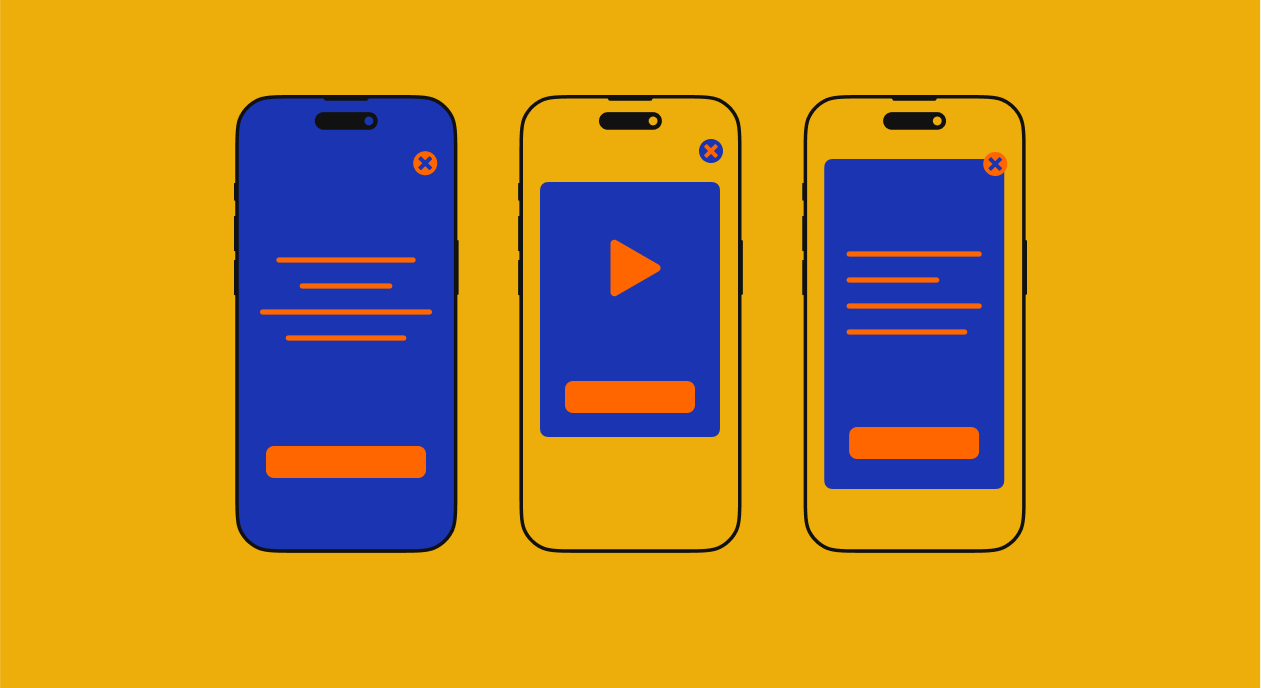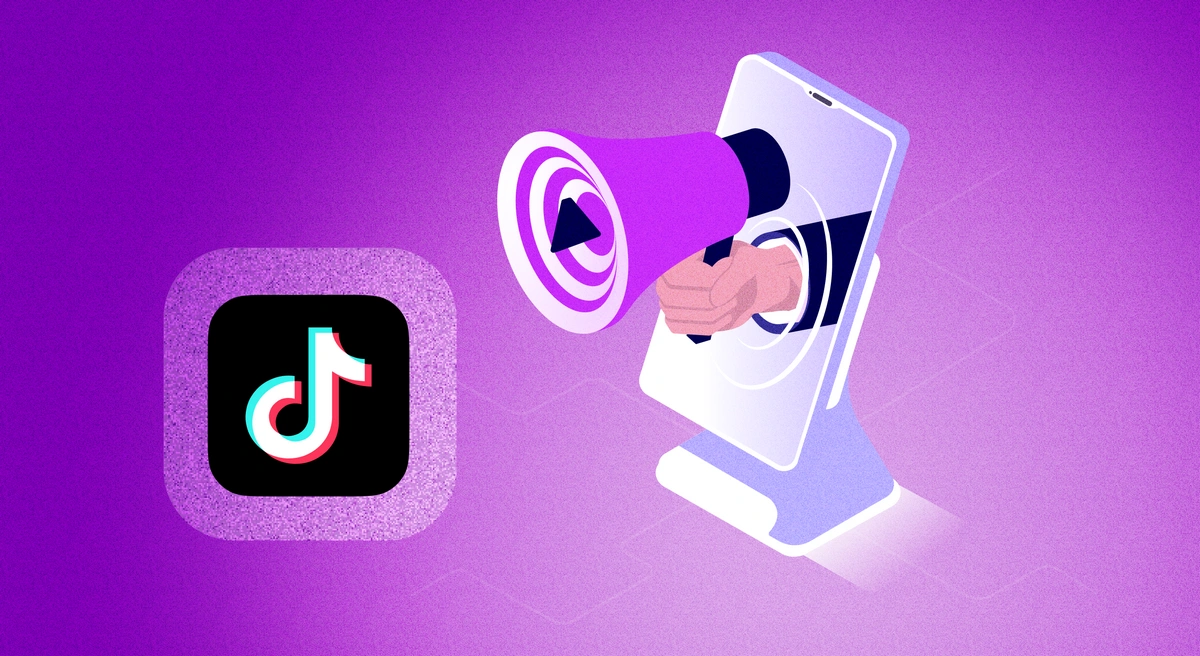What is one common element in high-converting websites, app marketing plans, and landing pages? Interstitial ads!
This relatively new ad format has grown quite quickly in the app industry, allowing marketers and app developers to curate an app marketing strategy that boosts conversions and engagement rates without annoying users in the process.
To help you make the best of your app advertisements, we’re covering all the basics you need to know to get started on your very own interstitial ads in mobile apps! Read on to find out everything there is to know about interstitial ads:
What are interstitial ads?
Interstitial ads are full-screen advertisements that pop up within an app during navigational moments or content transitions. These ads are designed to take up the entire visual space of your screen to offer a high-impact advertising experience by utilizing, full-screen pop-ups, overlays, or modal windows.
In recent years, the trend of interstitial ads has grown exponentially, and they can be implemented in various forms, including:
- Static images
- Videos
- Animations
- Interactive elements
But why are interstitial ads all the rage suddenly? And should you be concerned about it, now?
Why use interstitial ads?
There are many reasons why app marketers and app developers alike and running into interstitial ads like a moth to flame. And for the statistic lovers out there (such as me), this is where the fun really begins:
1. Increased revenue
Interstitial ads contribute significantly to revenue generation due to their high engagement and effective monetization strategies. Adnimation’s recent study found that interstitial ads offered a 4094% higher eCPM than banner ads.
Hence, they provide a lucrative opportunity to capitalize on user attention and interaction. This revenue boost is further enhanced by their ability to combat “banner blindness,” ensuring ads stand out more effectively within apps.
2. Higher CTRs than other ad types
According to Propeller Ads, that interstitial ads achieve an impressive click-through rate of 4-5% on Android. This is significantly higher compared to desktop interstitials and banner ads which highlights their effectiveness in driving user interaction and action.
Higher CTRs indicate that users are more likely to engage with interstitial ads, making them a powerful tool for advertisers aiming to maximize campaign performance.
3. Greater app install rates
One of the key benefits of interstitial ads is their ability to boost app install rates. They allow advertisers to showcase app features or gameplay directly within the ad, providing users with a preview that encourages downloads.
This approach leads to higher quality installs, as users are more informed and engaged before committing to download the app. With conversion rates exceeding 20% in Android and 15% in iOS, interstitial ads prove to be highly effective in driving app installations and user acquisition.
4. Improves engagement levels
Interstitial ads excel in capturing user attention and fostering deeper engagement compared to traditional ad formats. Their full-screen format and interactive elements such as videos or playable demos create immersive ad experiences that resonate with users.
Interstitials enhance user experience without interrupting the flow which results in increasing overall engagement and user satisfaction by presenting ads at natural breaks in app usage, such as between game levels or content transitions.
Key types of interstitial ads
Interstitial ads are one of the most creatively diverse types of in-app advertisements any app marketer can choose from. Here are 5 types of interstitial ads that you can display within an app, all with their unique characteristics:
Text interstitial ads
Text interstitial ads primarily use text to convey the advertising message. These ads are typically less visually intrusive and can be effective for delivering detailed information quickly. They are often used for promoting content, services, or offers where the main appeal lies in the message rather than the visuals.
Static image ads
Static image interstitial ads use a single image to capture user attention. These ads are straightforward and can be visually appealing if designed well. They are commonly used for branding, promotions, and announcements. Static image ads are easy to implement and generally load faster than other rich-media formats.
Video interstitial ads
Video interstitial ads use video content to engage users. These ads are highly effective for storytelling, product demonstrations, and creating an emotional connection with the audience. Video interstitial ads usually last between 15 and 30 seconds and can include sound, making them more immersive compared to static ads.
Rich-media ads
Rich-media interstitial ads are interactive and often combine multiple elements like text, images, video, and animation. These ads can engage users through interactive features, such as swiping, tapping, or shaking the device. Rich media ads are effective for creating a memorable user experience and encouraging user interaction with the brand.
Playable interstitial ads
Playable interstitial ads allow users to interact with a mini-version of a game or app within the ad itself. These ads provide a hands-on experience, making them highly engaging and effective for driving app installations. Playable ads give users a taste of the app’s features before they decide to download it, leading to higher-quality leads and installations.
Interstitial ads vs banner and pop-up ads
Of course, any smart app marketer will first weigh the pros and cons of interstitial ads with other ad types. But to make your analysis easier, I’ve gathered all the differences between interstitial ads, banners, and pop-up ads:
| Aspect | Interstitial Ads | Pop up ads | Banner Ads |
| Format | Full-screen ads covering the interface | Small windows appear over content | Rectangular image or text-based ads |
| Size | Full screen or large overlay (e.g., 320×480) | Typically smaller windows | Various sizes (e.g., 728×90, 300×250, etc.) |
| Placement | Shown during transitions (e.g., between pages) | Appear on top of the webpage content | Placed within the webpage content |
| Visibility | Highly visible, interrupts user flow | Highly intrusive, interrupts user activity | Passive visibility |
| Engagement | Higher engagement due to full attention | Often closed immediately, low engagement | Moderate, depending on placement and content |
| Pricing | Higher cost due to higher engagement rates | Medium cost | Generally lower cost |
| Use cases | High-impact campaigns, app installs, conversion transitions | Immediate call-to-action, lead generation | Brand awareness, promotions, informational |
Average rate for mobile interstitial ads in 2024
If the other ad formats aren’t pleasing in terms of their eCPM prices, here’s a fun fact for you: interstitial ads have the highest eCMP rates since 2021! But what do the leading providers pay out for interstitial ads?
Here is the complete breakdown of the average rate charged by the top providers in 2024:
| Platform | Country | Revenue |
| Admob | US | $11 for iOS, $6 for Android |
| Smaato | UK | Up to $10 for iOS. Up to $7 for Android |
| Epom | US | Up to $3.7 |
| Exoclick | US | Up to $2 |
| InMobi | UK | $2.5 for Android. $2.5 to $7.5 for iOS. |
| Startapp | US | $3 to $10 |
Google’s interstitial rules
Sometimes, reading the technical fine print on Google isn’t something we look forward to. In that case, I dived deep into all the rules Google has for interstitial ads and put them in simpler language for you to refer back to.
Here are all the rules you need to know when it comes to mobile interstitials:
- Placement: Interstitial ads should be placed at natural breaks or transitions within the app, such as between levels in games or after completing an action in non-game apps. They should not disrupt the user experience by appearing excessively or unexpectedly.
- Timing: Ads should be shown before navigation elements like “Next” buttons rather than after them. This prevents accidental clicks and ensures users can navigate seamlessly through the app.
- Frequency: Avoid displaying interstitial ads too frequently. They should complement the user experience rather than interrupt it. Overuse can lead to user frustration and negatively impact engagement.
- Size and Format: Ensure that ads are appropriately sized and formatted for the device screen. They should be visually appealing without overshadowing or obstructing the app’s content.
- Exit Options: Provide clear and easily accessible exit options for users to close the ad if they choose not to engage with it. This helps maintain a positive user experience and reduces frustration.
- Ad Content: Ads must comply with Google’s policies regarding content, including restrictions on sensitive topics such as adult content, illegal activities, and misleading claims.
How to avoid penalties for intrusive interstitial ads?
To avoid penalties for intrusive interstitial ads, it is crucial to implement them in a way that respects user experience and adheres to best practices. First, you should comply with every interstitial rule set by Google and/or Apple and don’t come off as intrusive or damaging.
Timing and user interaction are key factors in preventing intrusiveness. It is recommended to display interstitial ads before navigation elements such as “Next” buttons, rather than after. This prevents users from accidentally clicking on ads when they intend to proceed to the next part of the content.
Addressing potential ad latency is another important aspect. Network delays can cause interstitial ads to appear at unintended times, leading to a poor user experience. To mitigate this, consider preloading interstitial ads! Preloading ensures that ads are ready to be displayed at the appropriate moment without delay, maintaining a seamless user experience.
Best practices for implementing interstitial mobile ads
Now that you’re familiar with all the technical aspects of interstitial mobile ads, let’s talk about some tips and tricks that can change the game for your mobile interstitial ads! Here are our 3 expert-vetted tips for interstitial ads:
1. Focus on user experience
Always prioritize the user experience when implementing interstitial ads. Ensure that ads are relevant and not overly frequent, maintaining a balance between monetization and user satisfaction. Strategically place ads at natural breakpoints, such as between levels in a game or after several user actions in a non-game app, to minimize disruption.
2. Make the exit button accessible
Ensure that the exit button on interstitial ads is clearly visible and easily accessible. Users should be able to close the ad without difficulty, reducing frustration and improving their overall experience. A well-placed exit button helps prevent accidental clicks and fosters a more user-friendly interaction with the ad content.
3. Consider your timing and frequency
Carefully consider the timing and frequency of interstitial ads to avoid overwhelming users. Ads should be shown at appropriate moments, such as during transitions or natural breaks in the app’s flow.
Introducing a short delay before displaying an ad can also help reduce accidental clicks, particularly in apps with frequent user interactions. Avoid showing ads too frequently, as this can lead to user frustration and decreased engagement.
Final Thoughts
Interstitial ads represent a powerful tool in mobile app advertising, more now than ever. They create an effective way to engage users and boost your CTR without compromising user experience— at least when done right. In this blog, we’ve talked about interstitial ads in great depth, from what they are to the best tips and tricks you should know when implementing yours!




